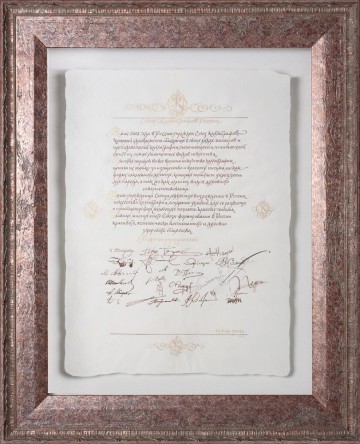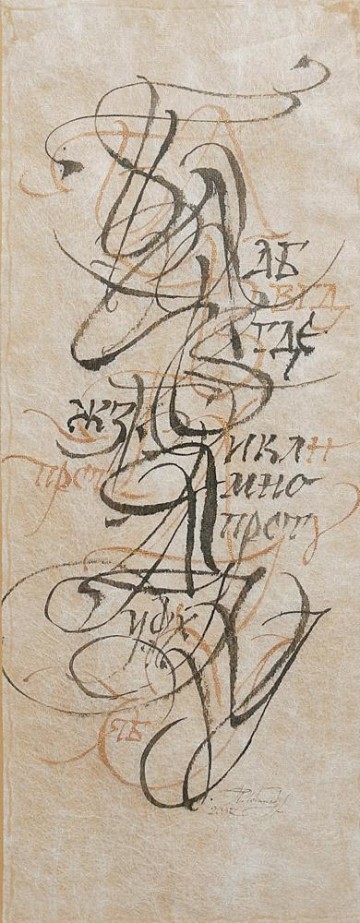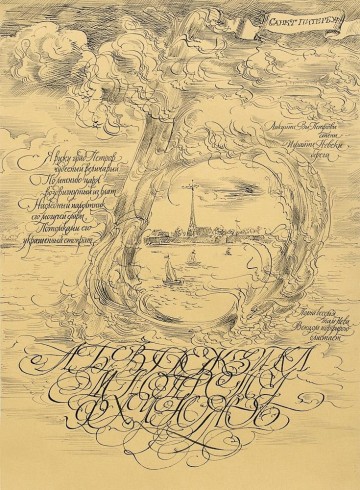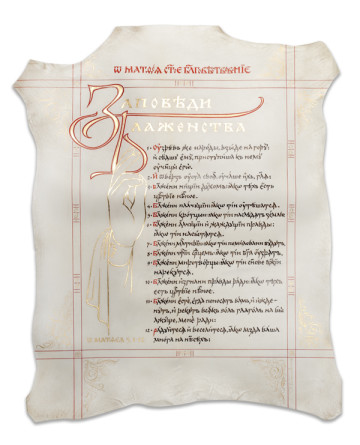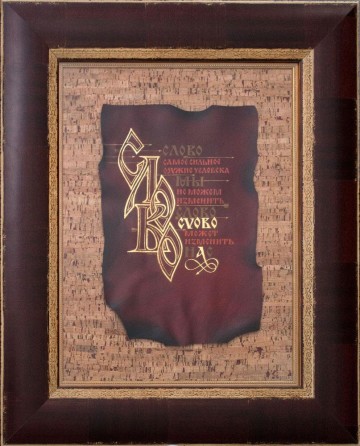乔比特科•彼得•彼得洛维奇

乔比特科•彼得•彼得洛维奇
圣彼得堡,俄罗斯
书法家艺术家,圣彼得堡工业科学院讲师,俄罗斯艺术家联盟成员
Cognitive and useful calligraphy
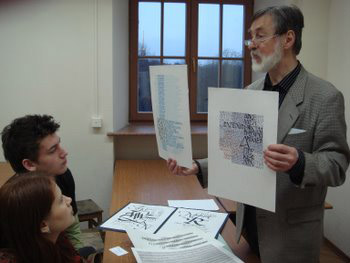
For centuries writing and calligraphy in Russia were intimately associated with the spiritual and cultural development of our people. They fastened national identity and showed its spiritual growth. While studying Old Russian writing we not only look back on our cultural origins but also penetrate into its perfect ideas about the world’s harmony. In textbooks of the 13th – 17th centuries in calligraphy there were lots of variants of writing letters. As distinguished from the contemporary study guides for children they could reflect the complexity of world organization. As every cell of a human organism carries a certain programme of its development every letter includes information closely connected with our language, writing, culture and spiritual traditions of our nation. Architect I. Shmelev once said that tradition is a temple for memory from which one can draw energy of inspiration, creation and development… And as long as people honour and save their traditions they are able to stand all the trials.
Old Russian lettering and calligraphy were very aware of any changes of everyday life: political, economical, cultural and religious changes. They had been influenced both by Western and Oriental Writings having saved and developed its own peculiarities. In Old Russia there were a great number of calligraphic schools. Large cloisters had their own scriptoria where monks practiced their skills in writing. Let us remember the Kiev Pechersk Lavra and Nestor the Chronicler, Sergius of Radonezh and School of Novgorod Archbishop Macarius, School of Ivan IV Vasilievich (Ivan the Terrible) and the Trinity Lavra of St. Sergius, Zaporizhia and Kiev-Mohyla Schools.
National character is carried by Writing and Lettering. That is why in times of war and danger people tried to save the most valuable things for them: manuscripts and books. During the long history of Russia a lot of samples of Old Russian writing were destroyed and the Lettering itself had been influenced by reforms and changes. Usage of a bird’s feather instead of writing sticks did not make the quality of letters worse but extended opportunities for masters and enriched the culture of lettering. The appearance of the ball pen in 1968 killed the rest of the traditions and lettering culture, and led modern society to total dysgraphia. In early 70s of the 20th century the well-known Estonian master and teacher Paul Luchtein warned that the pen would bring lots of trouble for the world’s culture. Today children write anyhow, holding pens as they want. As a result the young generations have poor word stock, cannot express thoughts and ideas both in oral and written forms.
In the East, calligraphy was as important as martial arts. It was considered a method of fortifying courage and a way of self-improvement.
Even in the 1st century B.C. calligraphy was recommended as the preliminary stage before starting to study art, trade, and sciences. Today many contemporary politicians and businessmen from Eastern and Western countries are engaged in calligraphy not only because it is very prestigious but also extremely useful. Try to spend just 20-30 minutes per day on calligraphy and make sure that they do not waste their time.
Physiologists and teachers of the 19th century noticed that calligraphy positively influenced the sensory organs of a person, developed and strengthened his/her character. They believed that “calligraphy is a medicine and training for human brains and soul.”
Calligraphy fosters the sense of lines, forms, texture, space, and rhythm. On the other hand it demands a considerable amount of inner efforts, but the results are irreplaceable in cultivation of such qualities as diligence, preciseness, patience, attention, moderation. Regular classes with calligraphic pen and bush help to cope with laziness, develop a quick eye, ability to concentrate and think logically. Finally, all the above mentioned factors, in their turn, contribute greatly to the development of artistic thinking and imagination.
V. Bazarny, a Doctor of Medical Science, is sure that the ball pen not only hinders hand muscles movements but also slows down the process of thinking and imagination. No wonder that from year to year the level of background of undergraduate applicants deteriorates. It is getting more and more difficult to find such students who are really capable of creative work.
Long-term research and development of methods of preparing specialists in the sphere of high technologies showed that calligraphy is the most effective way for reaching these purposes; it broadens a wide range of psychophysical peculiarities of students.
In fact overtly or covertly calligraphy interacts with other disciplines during the educational period in school. A teacher influences a student, forms his/her character, way of mind and inner world. Due to calligraphic skills a person begins to realize his/her responsibility for this or that action.
After 1917, the writing system in our country became a prerogative of civil servants. Like short-sighted farmers they seeded a field of lettering with strange hybrids, ignoring old traditions of Russian culture. As a result people forgot their historical and cultural bases; they do not understand now the real importance of calligraphy in forming and developing human personality. In pursuit of writing at a high speed we are losing our own personality; individuality and the beauty of our handwriting. The process of calligraphic writing is needed to teach us to fight against our vices. It is necessary to introduce and develop stenography. I am sure it will help us to regard speed and beauty of writing as two different disciplines. Really beautiful letters bring joy and harmony to the human soul.
Today one tries to substitute the process of word creation for a computer keyboard and this is, to my mind, a big mistake. Physiologists of Europe, Japan and Chinese have already proved that it can negatively affect the child’s physical and spiritual health. It is known that calligraphy develops fine motor skills and positively influences imaginative thinking.
A letter and a word are closely connected with each other. A word carries the peculiarities of the human soul. There are no insignificant things in any written letter; everything is important there: melody of a line, strength of pen pressure and length of a stroke.
Since the very first day of life till the last breath a written Letter accompanies us. Every day we have to face the myriads of letters. Some of them have such ugly forms that make us nervous, put to inconvenience, others like a beautiful melody, like prayer can fill our hearts with joy and delight. It is impossible to imagine any of the traditional field of Russian art without an inscription. It was always inextricably entwined with architecture, interiors of temples and buildings. Letters not just blended with an object, they fill it out with sense, joy and wealth.
Paul Luchtein’s forty-year long experience in teaching calligraphy in Tallinn shows that writing and lettering stimulate the perception of graphical composition; they are bases of applied and decorative arts, cultivation of artistic taste.
Using the experience of my teacher P. Luchtein I could evolve a new method of accelerated studies for young people entering the Institutions of Arts. With the help of special exercises students could find and demonstrate their inner hidden talents.
Nowadays office holders in the educational system ignore the experience of professional schools and specialists of Estonia, Lithuania, Belarus, Ukraine, and Russia. The old motto “we study not for school but for life” today can be changed into “we study for the unified national exam, for the Committee of the Russian Federation of Standardization (CRFS)”. Not one University trains specialists in the sphere of calligraphy and lettering art. And no wonder, under the existing circumstances it is just impossible because this is not enacted by CRFS. But numerous documentary records and favourable reports of those who have already touched the spring of exquisite beauty show quite the opposite. In one of the schools of St.-Petersburg where calligraphy is a basic discipline children call lessons in calligraphy “in-home delight” and it is true. When we take a pen, slowly and carefully trying to copy the marvelous forms of Old Russian letters, we feel how they echo in our souls.
Organizers of the project open up unique opportunities for everyone to touch a handwritten Letter. It may awake a wish to take a pen, ink and paper and create a new form of letter. We hope no one will be untouched by this unique and great project.For centuries writing and calligraphy in Russia have been closely connected with the spiritual and cultural infancy of the nation, they contributed to the strengthening of national self-consciousness and spiritual development. By studying ancient Russian script we are going back to our cultural roots and comprehend the ideal knowledge of the world′s harmony enclosed in it.
“Calligraphy is the medicine and gymnastics for a person′s mind and soul”
